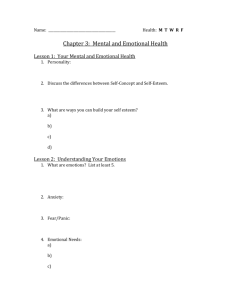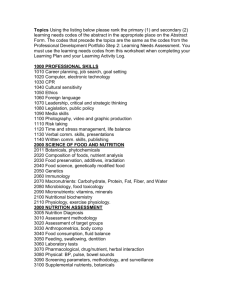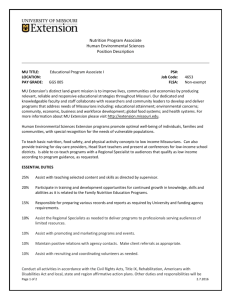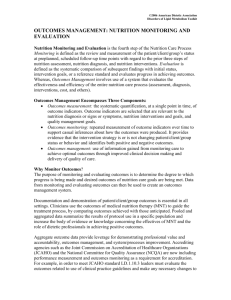Disorders of Lipid Metabolism Toolkit
advertisement
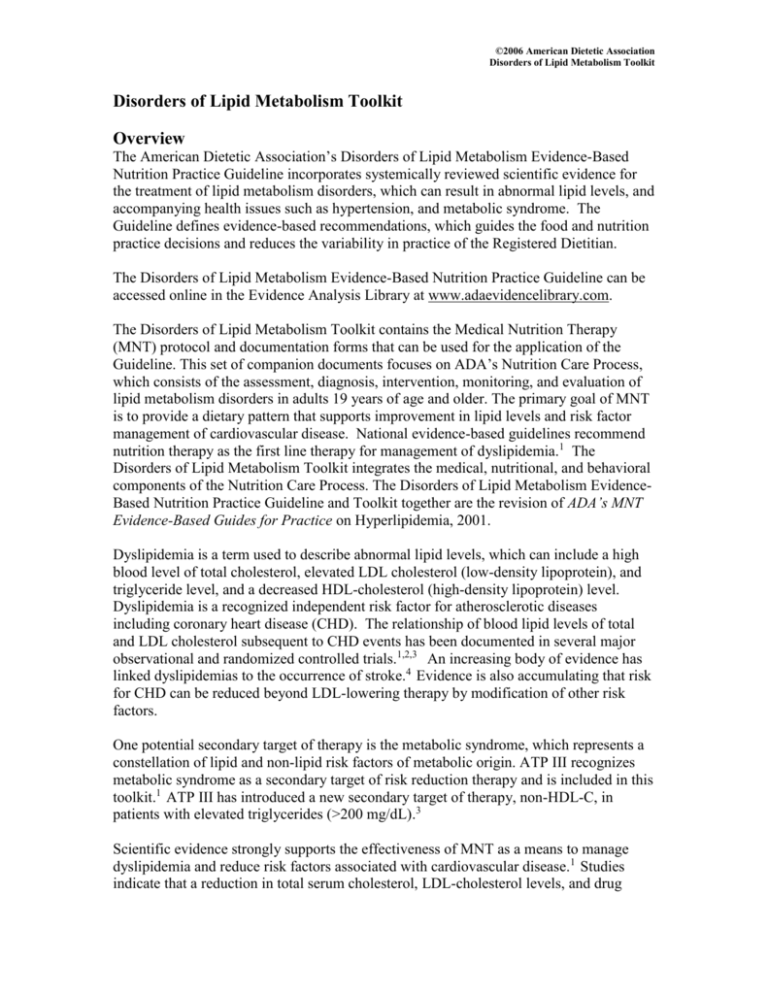
©2006 American Dietetic Association Disorders of Lipid Metabolism Toolkit Disorders of Lipid Metabolism Toolkit Overview The American Dietetic Association’s Disorders of Lipid Metabolism Evidence-Based Nutrition Practice Guideline incorporates systemically reviewed scientific evidence for the treatment of lipid metabolism disorders, which can result in abnormal lipid levels, and accompanying health issues such as hypertension, and metabolic syndrome. The Guideline defines evidence-based recommendations, which guides the food and nutrition practice decisions and reduces the variability in practice of the Registered Dietitian. The Disorders of Lipid Metabolism Evidence-Based Nutrition Practice Guideline can be accessed online in the Evidence Analysis Library at www.adaevidencelibrary.com. The Disorders of Lipid Metabolism Toolkit contains the Medical Nutrition Therapy (MNT) protocol and documentation forms that can be used for the application of the Guideline. This set of companion documents focuses on ADA’s Nutrition Care Process, which consists of the assessment, diagnosis, intervention, monitoring, and evaluation of lipid metabolism disorders in adults 19 years of age and older. The primary goal of MNT is to provide a dietary pattern that supports improvement in lipid levels and risk factor management of cardiovascular disease. National evidence-based guidelines recommend nutrition therapy as the first line therapy for management of dyslipidemia.1 The Disorders of Lipid Metabolism Toolkit integrates the medical, nutritional, and behavioral components of the Nutrition Care Process. The Disorders of Lipid Metabolism EvidenceBased Nutrition Practice Guideline and Toolkit together are the revision of ADA’s MNT Evidence-Based Guides for Practice on Hyperlipidemia, 2001. Dyslipidemia is a term used to describe abnormal lipid levels, which can include a high blood level of total cholesterol, elevated LDL cholesterol (low-density lipoprotein), and triglyceride level, and a decreased HDL-cholesterol (high-density lipoprotein) level. Dyslipidemia is a recognized independent risk factor for atherosclerotic diseases including coronary heart disease (CHD). The relationship of blood lipid levels of total and LDL cholesterol subsequent to CHD events has been documented in several major observational and randomized controlled trials.1,2,3 An increasing body of evidence has linked dyslipidemias to the occurrence of stroke.4 Evidence is also accumulating that risk for CHD can be reduced beyond LDL-lowering therapy by modification of other risk factors. One potential secondary target of therapy is the metabolic syndrome, which represents a constellation of lipid and non-lipid risk factors of metabolic origin. ATP III recognizes metabolic syndrome as a secondary target of risk reduction therapy and is included in this toolkit.1 ATP III has introduced a new secondary target of therapy, non-HDL-C, in patients with elevated triglycerides (>200 mg/dL).3 Scientific evidence strongly supports the effectiveness of MNT as a means to manage dyslipidemia and reduce risk factors associated with cardiovascular disease.1 Studies indicate that a reduction in total serum cholesterol, LDL-cholesterol levels, and drug ©2006 American Dietetic Association Disorders of Lipid Metabolism Toolkit therapy increases with the level of time spent with the registered dietitian. Evidence supports the need for two to six visits with the registered dietitian to achieve optimal outcomes.1,5,6,7 Population groups, medical conditions, or coexisting diagnoses, where the Disorders of Lipid Metabolism evidence-based nutrition practice guidelines may be indicated include: Coronary heart disease Cerebral vascular disease Peripheral vascular disease Familial or combined hyperlipidemia, hypertriglyceridemia, hypercholesterolemia, hypoalphalipoproteinemia Metabolic syndrome Diabetes mellitus History of cardiovascular disease and dyslipidemia in first degree relatives Hypertension Myocardial infarction Obesity and smoking Cardiovascular disease is the leading cause of death and a major contributor to health care utilization.2 According to data compiled by the American Heart Association (2005), the cost of cardiovascular diseases in 2005 was estimated at $393.5 billion.8 The nutrition prescription goes beyond the realm of fat intake, integrating the use of food sources providing key nutrients that have demonstrated improvement in lipid management and cardiovascular disease outcomes. In addition, the registered dietitian plays an active role in assisting the interdisciplinary team in designing the optimal nutrition prescription that coincides with pharmacotherapy when necessary. The nutrition prescription and nutrition outcomes monitors are based on disease severity and comorbid conditions. Based on the client’s treatment plan and comorbid conditions, other nutrition toolkits such as Hypertension, and Type 2 Diabetes Mellitus may need to be combined as part of optimal treatment. Included in the Disorders of Lipid Metabolism Toolkit are the following documents: Medical Nutrition Therapy Protocol for Implementing Disorders of Lipid Metabolism Evidence-Based Guideline: a set of steps that define the level, content, and frequency of nutrition care that is appropriate for Disorders of Lipid Metabolism within an ambulatory setting, based on the Nutrition Care Process. Summary Page: includes the recommended encounters for medical nutrition therapy, and provides a summary of outcomes assessment factors, expected outcomes, and ideal values for MNT, ideal values are based on scientific evidence with the evidence strength indicated (Grade I – good/strong, Grade II – fair, Grade III – limited/weak, Grade IV- expert opinion, Grade V – grade not assignable). Flowchart: an overview of the process that includes the timeline and a brief description of how to conduct each client encounter organized by assessment, diagnosis, intervention, evaluation, and monitoring. ©2006 American Dietetic Association Disorders of Lipid Metabolism Toolkit Encounter Process: a detailed set of instructions for each client encounter organized by assessment, diagnosis, intervention, evaluation, and monitoring; specifically describes suggested clinical and nutritional data to obtain, related nutrition diagnoses, pertinent nutrition education, and the outcomes to measure and evaluate. Document may be used to train and orient new staff or students. Sample Referral form: a one-page form for physicians to complete in order to justify the need for medical nutrition therapy and give the practitioner a brief health history on the client. Nutrition Progress Notes (initial and follow-up): documentation forms for the paper or electronic medical record, uses narrative notation to be used at each encounter, that are specific to disorders of lipid metabolism. Forms should be used in coordination with ADA’s Nutrition Diagnosis: A Critical Step in the Nutrition Care Process, 2006 (http://www.eatright.org/cps/rde/xchg/ada/hs.xsl/career_912_ENU_HTML.htm). Progress note forms may be adapted to meet specific needs of the facility or dietitian. Sample Case Studies: client cases that illustrate the use of the Initial and Follow-up Nutrition Progress Notes, using the nutrition care process, while highlighting clients with lipid metabolism disorders. Outcomes Monitoring Forms: individual and aggregate forms which, allow the monitoring of client and population outcomes; used to document client progress at each encounter or a population’s progress over time, in order to guide the treatment process and evaluate the need for future MNT. Client Education Resources: a list of resources available through ADA for client education, highlighting those found in the Nutrition Care Manual (NCM); several food/nutrient-specific handouts related to Disorders of Lipid Metabolism, the Toolkit resources have not duplicated any client education found in the NCM, but may be used in combination with these resources; an Agreement for Care, which can be used to outline the goals and expectations of nutrition therapy and the dietitian’s role for the client, encourages collaboration between dietitian and client in determining client goals for nutrition therapy. Appendices: includes guidelines for assessing overweight and obesity, ATP III LDL-C goals and cut-points for TLC and drug therapy, Framingham risk scoring system, and criteria for diagnosing metabolic syndrome. In summary, this toolkit provides practitioners with guidance in applying the Disorders of Lipid Metabolism Evidence-Based Nutrition Practice Guidelines in the provision of Medical Nutrition Therapy to their clients. The materials incorporate use of the Nutrition Care Process with case studies illustrating pertinent nutrition diagnoses. Used in conjunction with the online Evidence Analysis Library, these tools enable dietetic practitioners to individualize a nutrition plan based on the current state of science, client values, clinical judgment, and monitoring of outcomes. ©2006 American Dietetic Association Disorders of Lipid Metabolism Toolkit References: 1. Third Report of the Expert Panel on Detection, Evaluation, and Treatment of High Blood Cholesterol in Adults. Washington, DC: US Dept of Health and Human Services, Public Health Service; 2001. NIH Pub 01-3095. 2. Institute of Medicine, Committee on Nutrition Services for Medicare Beneficiaries. The Role of Nutrition in Maintaining Health in the Nation’s Elderly: Evaluating Coverage of Nutrition Services for the Medicare Population. Washington, DC: National Academy Press, 2000. 3. Grundy SM, Cleeman JI, Merz CN, Brewer HB Jr, Clark LT, Hunninghake DB, Pasternak RC, Smith SC Jr, Stone NJ, for the National Heart, Lung, and Blood Institute; American College of Cardiology Foundation; and American Heart Association. Implications of recent clinical trials for the National Cholesterol Education Program Adult Treatment Panel III guidelines. Circulation. 2004; 110: 227–239. 4. Ross SD, Allen IA, Connelly JE. Clinical outcomes in statin treatment trials: a metaanalysis. Arch Intern Med. 1999;159:1793-1802. 5. Sikand G, Kashyap ML, Wong ND, Hsu JC. Dietitian intervention improves lipid values and saves medication costs in men with combined hyperlipidemia and a history of niacin noncompliance. J Am Diet Assoc. 2000; 100:218-224. 6. McGehee MM, Johnson EQ, Rasmussen HM, Sahyoun N, Lynch MM, Carey M, Massachusetts Dietetic Association. 1995. Benefits and costs of medical nutrition therapy by registered dietitians for patients with hypercholesterolemia. J Am Diet Assoc. 1995; 95:1041-1043. 7. Dalgard C, Thuroe A, Haastrup B, Haghfelt T, Stender S. Saturated fat intake is reduced in patients with ischemic heart disease 1 year after comprehensive counseling but not after brief counseling. J Am Diet Assoc. 2001; 101:1420-1424. 8. American Heart Association. Heart Disease and Stroke Statistics-2005 Update. Dallas, TX: American Heart Association; 2005. Available at: http://www.americanheart.org/downloadable/heart/1105390918119HDSStats2005Up date.pdf. Accessed February 10, 2006.
